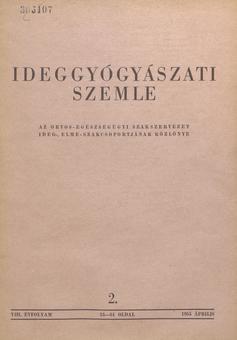The eLitMed.hu medical portal uses computer cookies for convenient operation. Detailed information can be found in the Cookie-policy.
Clinical Neuroscience - 1955;8(02)
Content
[Central nervous system and RES III. Data on the neurohormonal regulation of liver RES]
[Our experiments were carried out on 160 rats. The aim of the experiment was: to clarify the neuroendocrine regulation of liver storage. The experimental methodology used was the stabilized Törő-Velősy procedure. Results: 1. insulin, depending on its dosage, greatly reduces storage in the liver and this is reduced to V4 of normal at very high doses. The reduction is not dependent on blood glucose levels. 2. After removal of the frontal cortex, insulin cannot exert the above effect. 3. adrenalectomy reduces storage greatly, by 72.6% at two days and 29.0% at one week. 4. Storage of adrenalectomised rat is increased by adrenaline dose-dependently, but cannot compensate. 5. DOCA can compensate for the decrease caused by adrenalectomy. 6. DOCA induces a decrease in storage in healthy animals. 7. The storage stimulating effect of the central nervous system is lost after adrenalectomy, with storage reduced to below normal levels.]
[Post-concussion amnesticus syndrome]
[He describes the amnesticus syndrome after concussion based on his own cases and the literature. After a historical review, he points out that commotional psychosis is essentially a common manifestation of all "exogenous" psychoses. In addition to the common symptoms, he found personality changes, lack of interest and initiative, disturbances in the perception of time, time perception, mood, and asocial behaviour. His experiences in terms of gender distribution, prognosis and therapy. In addition to pathological literature, he details the basic structure of the dynamic localization and pathophysiology of the amnesticus symptom complex according to Pavlovian physiological principles.]
[Employment of the mentally ill in Intapusta]
[In the 80-bed experimental occupational therapy unit in Intapuszta, which began operating in 1952, 250 patients were seen in 2 years. Of the 200 patients discharged, 62 per cent went home or returned to work with improvement. Since the material consists exclusively of defect patients (inveterate, hospitalised cases), this recovery percentage is surprisingly high. In addition, 41 patients have recovered to the point where they could not work independently but could be sent home if their social situation allowed it. The patients who have improved but cannot be discharged for social reasons are slowly filling up the ward and paralysing its dynamism. The essence of the environmental therapy method: maximum freedom, good treatment, constant occupation with the patients, purposeful productive work in such a way that the patient is ambitious to do the work and sees it as his own business; care for sports, games, intellectual entertainment; to create a family environment in which the patient feels at home; to help those who can be brought back into real society step by step, with the help of an 'artificial but not unnatural' society; to provide a pleasant environment and a complete home with work and entertainment for those who cannot find their way back into real society. In this way, 60 per cent of the patients worked well, 18 per cent moderately well, and 56.8 per cent of the patients felt very well and 25.2 per cent felt well in Intapusztas.]
1.
Clinical Neuroscience
[Headache registry in Szeged: Experiences regarding to migraine patients]2.
Clinical Neuroscience
[The new target population of stroke awareness campaign: Kindergarten students ]3.
Clinical Neuroscience
Is there any difference in mortality rates of atrial fibrillation detected before or after ischemic stroke?4.
Clinical Neuroscience
Factors influencing the level of stigma in Parkinson’s disease in western Turkey5.
Clinical Neuroscience
[The effects of demographic and clinical factors on the severity of poststroke aphasia]1.
2.
Clinical Oncology
[Pancreatic cancer: ESMO Clinical Practice Guideline for diagnosis, treatment and follow-up]3.
Clinical Oncology
[Pharmacovigilance landscape – Lessons from the past and opportunities for future]4.
5.



